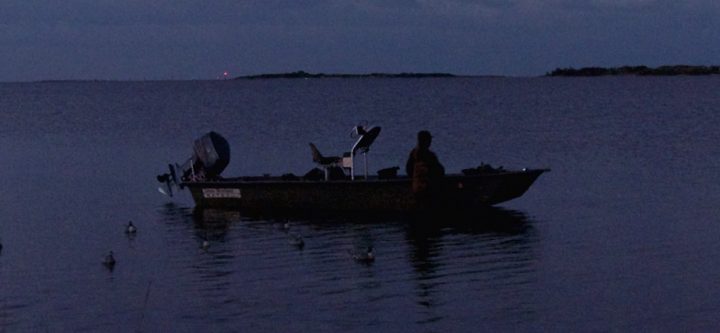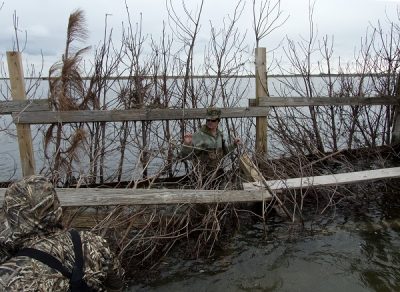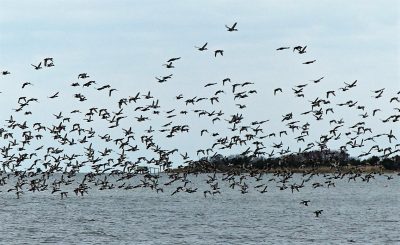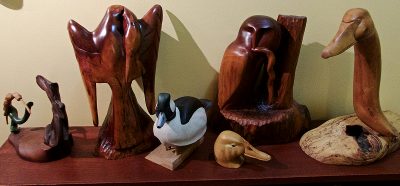
DARE COUNTY — It’s 4:30 a.m. and we’re meeting at the local 7-11, which seems to be the only place on the Outer Banks open that early in the morning. There’s a couple of other hunters, another guide and Vic Berg, who may be the most experienced guide on the Outer Banks. We form a small caravan as we head south to Oregon Inlet.
Berg’s island and his blinds are near the protected areas of Pea Island and Bodie Island and he is explaining what to expect and why.
Supporter Spotlight
“We’re a choke point. Everything that comes from Canada and flies the Eastern Seaboard all converges on the Outer Banks. Some will stay, but most will keep going farther south to Florida, some even to South America,” Berg says.

“There’s different phases to the seasons. Early in the season all the new birds arrive, and the refuges are fresh and full of food that have grown over the summertime,” he explains. “But it’s not until the multitudes of birds get up and eat all the food that is in the refuges that they show up. Usually by Christmas your big groups of redheads and diver ducks show up. The hardier the birds the later they get here. Early in the year you’ll probably have the best four days of the year because the birds are naive and haven’t been shot at yet. But you’ll probably also have seven or eight of the worst days of the year because the weather’s pretty, they don’t have the food requirements and food is available where they’re not in jeopardy.”
We leave the boat slip by Coast Guard Station Oregon Inlet by 5:30, a full hour before sunrise. Berg knows these waters well, but he navigates his way carefully in the slough as we skirt unmarked shoals.
The blind is on a slight rise in the marsh, barely noticeable from the water and camouflaged by bayberry branches laid against the walls.
It’s early season and the day promises to be cool but not cold, so there’s no telling what we’ll see, although Berg seems confident that bufflehead, an early season bird, will make an appearance.
Supporter Spotlight
As dawn approaches, Berg is on the water laying out decoys. With 26 species of duck available to hunters in North Carolina, there is a skill and a science to that all its own.
“You have to figure how best to represent the species you will get. You have to adjust how you put your decoys out to highlight the desires of the duck you’re looking for,” he says.
After more than 50 years of hunting on the Outer Banks and 42 years as a guide, the magic of being in a blind early in the morning in November or December with the wind blowing across the marsh is still there.
“I just love it,” Berg says. “Seeing ducks with their wings set is what keeps me keeping back time after time. Everything has gone absolutely right, the birds are beautiful, the day is awesome, the meal that night is going to be awesome.”
He first started coming to the Outer Banks with his father, Vernon Berg, a Navy chaplain.
“By ’63 or ’64 he had discovered the Outer Banks. By ’66 he would take me out of school for a week each year to come down here to hunt with him,” Berg recalls. “You’re a young kid and there’s all these grownups and you’re seeing another side of the preacher man that you didn’t quite know was there.”
His father liked the Outer Banks so much that he bought a piece of a marsh island east of the Oregon Inlet Coast Guard Station and started Outer Banks Waterfowl Guide Service.

“He purchased the marsh in ‘77. If you put a circle around our part, it’s probably about 45 acres of actual land,” Berg says. “This is our 42nd year.”
Vic Berg was in college at the time. He graduated with a double major in philosophy and biology in 1980.
“The philosophy helps me make conversation,” he says.
After graduation he came back to work with his father, but nepotism didn’t seem to play a role.
“It took me a couple of years until I got out of school (to be) guiding on a regular basis. I was guiding some. I was more doing the background work, cleaning ducks, duck blind building, that kind of stuff,” Berg says.
Vernon died in 1984 and Vic Berg inherited Outer Banks Waterfowl Guide Service.
With so much history behind him, Berg has seen cycles of plenty and scarcity.
“The late ‘70s to early ‘80s were just banner years for duck, stupendous in a lot of respects. From say ‘84 or ’85, there was a big decline. Since the late ‘90s it improved steadily,” he says.
He has also learned a lot about some hunters and human nature in general.
“I’ve had first-evers and best-evers with guys in their ‘80s. They almost cry,” he says.
There have also been scary moments.
“You’re in a blind with lethal weapons,” he says. “A couple of years ago we had somebody blow a hole in the floor of the duck blind because he wanted to see if the safety worked by pulling the trigger.”

And there was perhaps his scariest moment.
“I’ve actually had a gun bounce off my chest and go off. I went home. You’re not going to get a second chance at me,” he says.
Along the way, he has learned what it means to be truly professional and that not everyone is going to appreciate that.
“If they’re scaring our guides or they’re just wanting to kill everything they can kill, we’ll give them their money back and tell them we’re not the service for them,” he says.
The day proves to be mostly uneventful. The hunters in the other blind with Jamie Ward, the guide with Berg, got a few duck. In our blind, it wasn’t a busy day, but a couple of bufflehead were going home with the hunter.
On the Outer Banks, Berg is pretty well known, although that’s mostly for his bird carvings. Like his hunting, it was a skill he learned from his father.
“My dad was making his own decoys for his own use … when he came out of the Navy, he had non-Hodgkins lymphoma. So, he was doing the duck guiding, but also more carving,” he says.

“The whole key in carving is in putting life in it,” he says. “It’s the decades of looking at live birds.”
When he sets up a booth, he mostly displays shorebirds, an occasional cardinal or owl and a some of the species of fish that swim in local waters. There are also, occasionally, pieces he has created that are sculpted from a block of wood, but those aren’t where the market is.
“If it was up to me and what I would prefer to carve if money wasn’t an object whatsoever, I would go with sculpture,” Berg says. “I can do a really funky, sexy swan out of the butt cut out of a white cedar tree.
“I started hunting when I was 8,” he continues. “It’s been 55 years I’ve been looking at live birds. With the love that you have for it, you’re looking at the nuance more than the overall. That’s where it goes from a block of wood to something that has life to it.”







